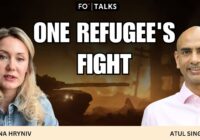The European Union is operating in crisis mode with its migration policy by wrongly focusing on containment.
Issues of migration and forced displacement have dominated public debate in EU member states for the third consecutive year. The feeling of having lost control over immigration weighs heavily on them, and has led to somewhat distorted perceptions of the issue of migration to Europe.
Against this backdrop, European policy has so far focused primarily on curbing irregular migration. This narrow focus prevents urgent migration and integration policy challenges from being addressed as well as the reform of the Common European Asylum System. In order to deal straightforwardly with these challenges and develop strategies, four realities must be accepted.
First, the number of irregular arrivals in the European Union this year is expected to remain below 150,000, the same level as in the years before the so-called “refugee crisis.” Nevertheless, the EU continues to operate in crisis mode rather than addressing the issue of sustainable migration management.
Second, migration is a fact that can never be completely prevented. Migration policy arrangements with Turkey and Libya have contributed to a considerable reduction in the number of arrivals in Italy and Greece. The example of Spain, however, shows that such arrangements are unlikely to be successful in the long term. Despite its longstanding cooperation with Morocco, Spain recorded double the arrivals this year compared to last.
A third fact is that a policy primarily aimed at containment has considerable side-effects. For example, the expansion of border controls promoted by the EU and the criminalization of migration that was previously regarded as legal are shifting migration toward much more dangerous routes, such as in Niger. Smuggler networks from other countries have assumed partial control of the transport.
In addition, the risk of drowning in the Mediterranean Sea during attempted crossings has increased. Out of every 1,000 attempts, four were fatal in 2014, increasing to 24 in 2018. The most dangerous is the central Mediterranean route, where the capacity for sea rescue has been reduced following pressure from the Italian government.
Thus far, the EU has outsourced its responsibility to the Libyan coastguard, which is picking up more and more migrants in the Mediterranean and bringing them back into the country. The number of people who have to remain in overcrowded detention centers under inhumane conditions has increased enormously as a result. The humanitarian plight of these people is therefore aggravated by EU policies.
Maritime rescue must be treated as a common European task and should be given appropriate significance in an expanded mandate for the European Border and Coast Guard, Frontex. However, the countries concerned on the European Union’s external border will only conceivably give their necessary consent if the member states agree on a common asylum procedure and a distribution mechanism for those entitled to protection.
Such an agreement is currently not in sight. Member states have agreed on actions outside the EU, such as the EU Trust Fund for Africa (EUTF), which was set up at a meeting of European and African leaders in Valletta in 2015 and has become the main instrument of EU external migration policy. The fund finances the development of border protection capacities in Libya and Niger, but also development policy projects. The latter are intended, for example, to compensate for the financial losses caused by the disappearance of the informal migration economy in Niger.
Powerful EU member states now demand that the fund should primarily concentrate on migration and border management and security cooperation with certain regions. This reduces funds for long-term development policy projects, for example, to support the local integration of refugees and internally displaced persons in the Horn of Africa so as to decrease the likelihood of further migration (known as secondary migration).
Migration Mainly within Africa
The preoccupation with curbing migration is heightened by voices that fuel fears of an African “invasion” of Europe. This fear has no empirical basis.
The fourth fact that should be taken into account in the debate on EU migration policy is that the majority of migration movements take place within Africa. According to French demographer François Héran, this will continue to be the case. He reasons that the greatest population increases are to be expected in sub-Saharan Africa whose nationals emigrate relatively rarely compared to other regions. According to his prognosis, their share of the total population of OECD countries will increase from 0.4% to only 2.4% by 2050.
 In this context — and given the demographic challenges in Europe — the EU should not aim to prevent migration movements in general. Rather, it should work to transform unregulated migration into regulated migration. This can reduce the risks for migrants. Furthermore, regular channels provide migrants with opportunities that can be advantageous for host countries and for the sustainable development of their countries of origin.
In this context — and given the demographic challenges in Europe — the EU should not aim to prevent migration movements in general. Rather, it should work to transform unregulated migration into regulated migration. This can reduce the risks for migrants. Furthermore, regular channels provide migrants with opportunities that can be advantageous for host countries and for the sustainable development of their countries of origin.
This is the aim of the Global Compact on Migration, a declaration of intent that is not binding under international law. However, this agreement goes too far for several EU member states, who have announced that they will not be joining the pact. Their refusal will not help them to make progress on the issue. In order to politically shape global migration movements, there must be cooperation between countries of origin and host countries.
*[This article was originally published by the German Institute for International and Security Affairs. The text was translated into English by Tom Genrich.]
The views expressed in this article are the author’s own and do not necessarily reflect Fair Observer’s editorial policy.
Support Fair Observer
We rely on your support for our independence, diversity and quality.
For more than 10 years, Fair Observer has been free, fair and independent. No billionaire owns us, no advertisers control us. We are a reader-supported nonprofit. Unlike many other publications, we keep our content free for readers regardless of where they live or whether they can afford to pay. We have no paywalls and no ads.
In the post-truth era of fake news, echo chambers and filter bubbles, we publish a plurality of perspectives from around the world. Anyone can publish with us, but everyone goes through a rigorous editorial process. So, you get fact-checked, well-reasoned content instead of noise.
We publish 2,500+ voices from 90+ countries. We also conduct education and training programs
on subjects ranging from digital media and journalism to writing and critical thinking. This
doesn’t come cheap. Servers, editors, trainers and web developers cost
money.
Please consider supporting us on a regular basis as a recurring donor or a
sustaining member.
Will you support FO’s journalism?
We rely on your support for our independence, diversity and quality.






